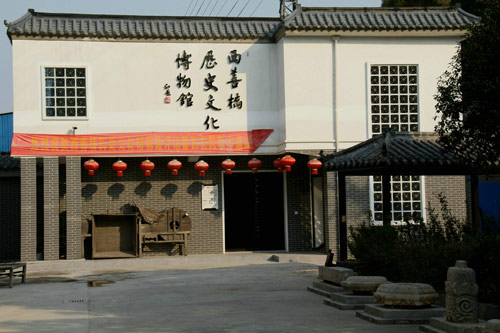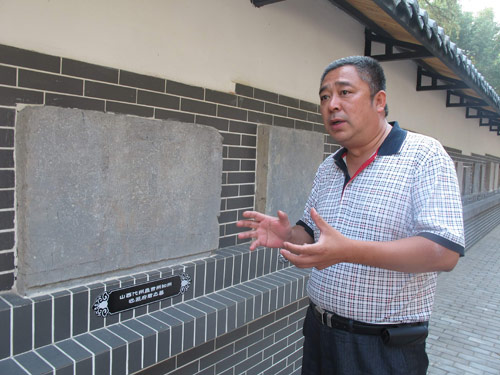 |
|
Xishanqiao museum is the only community-level cultural history museum in Nanjing, capital of Jiangsu province. Song Wenwei / China Daily |
He spent seven years collecting and researching the rich culture and history of Xishanqiao, a community in southwest Nanjing. Zhu Xiangdong is credited for establishing a museum to house his collections and promoting intangible heritage. He shares more with Wang Kaihao.
The unassuming structure can be easily missed. But those who enter the two-story building will never regret their decision.
It is the only community-level cultural history museum in Nanjing, capital of Jiangsu province.
Located in Xishanqiao in southwest Nanjing, the treasure house covering an area of 2,000 square meters was the former headquarters of the village committee.
The man behind the resource gallery is 50-year-old Zhu Xiangdong, who is also the deputy head of the community committee.
He says the grounds of Xishanqiao are rich with history.
"You will find tombs of important figures from ancient dynasties, simply by digging a hole here. No one knows how many legends are buried underground," he says.
The community spent 1.3 million yuan ($208,000) from local residents' cable television fees in renovation and launched the museum in January 2012. Visitors can enter for free.
At the entrance of the museum stand 32 ancient steles carved with epitaphs. They are the names of dignitaries from different dynasties. Some of the names are well-known figures but there were also lesser-known officials.
But, the locals are oblivious to the treasures they are stepping on.
"People here have gotten used to these ancient articles," says Yao Dalong, a staff from the community culture center, who is also a local villager. "Many steles were used as part of the building materials of villagers' houses or abandoned in the courtyard."
But Yao says after witnessing Zhu's long effort, he is glad that villagers are now more aware and will report to the museum if they find antiques in the fields.
Nanjing was the capital of six dynasties from 3rd to 7th century AD. It is also the place where Zhu Yuanzhang established his powerful Ming Empire (1368-1644). Numerous high officials during those times were buried in Xishanqiao, where more than 200 important tombs have so far been found.
More than 500 antiques are exhibited in the museum, while abundant maps and pictures give detailed introduction to local history.
"I wrote all the captions," says Zhu, as he introduces the exhibits that took him seven years to put together, with pride. "I've checked every history book I could find relevant to Xishanqiao. During office hours, I am occupied with my daily chores, but I try to squeeze some time in between work, stay up late or wake up very early to continue my research.
Xishanqiao began large-scale urbanization in 2006. When the villages were demolished, there were abandoned furniture and other daily use items. Zhu collected a lot of them but realized that the museum was not big enough to exhibit everything.
"Collection is a dynamic process," says Zhu. "We record what happens today as part of history, as a responsibility to our children."
Zhu, whose hometown is Ulanqab, Inner Mongolia autonomous region, served in People's Liberation Army for 25 years before coming to Xishanqiao in 2004. He has been a fan of folk arts like clay sculpture and paper-cutting since he was a child, and describes himself as a "folk arts fanatic".
He opines that it is equally important to preserve intangible treasures and his most precious collection is local folk songs in old Nanjing dialect.
"Younger generation doesn't sing these songs any more. Once the living history is lost, it will be almost impossible to get them back."
He was thus glad to meet Xie Fabao, a retired high school Chinese teacher in Tianjin, in 2006.
Xie, 72, was born and bred in Xishanqiao. In 1963, he left for Beijing Normal University to study Chinese literature. He recalls having a cousin who often sang ballads when laboring in the fields in Xishanqiao.
"I first recorded his melodies out of curiosity," says Xie, who is also a music lover. "Then I discovered that Nanjing is an ocean of ballads, and made use of every break I got to go back to my hometown to collect them. These pieces record the residents' love, labor and diverse social activities. They are a true reflection of the locals' history and folklore."
He feels blessed to be someone who understands Chinese literature, music and local dialect. He spent three decades collecting music from all over Nanjing but found it too huge a task to finish on his own. Finally, he decided to focus on his birthplace.
Xie did a trip around Xishanqiao before selecting 11 old people who can sing folk songs well to organize a band. They were in Beijing in late October to sing Song of Tamping for China Central Television's annual Chinese folk music gala, and claimed to be the only community-level chorus in the show.
Xie's book Xishanqiao Ballads Collection, which includes more than 200 folk songs, was published in 2009. He plans to publish a more complete version containing more than 400 music pieces. The audio version of the book is also in the pipeline.
Riding on his encounter with Xie, Zhu plans to establish a scholarship to encourage the younger generation to take an interest in the old melodies. He will reward students from three local elementary schools who are able to sing a complete traditional ballad.
"To keep the original lyrics is a problem," Zhu expresses his concerns. "Folk songs are a reflection of a certain time period. Maybe we should also add some new content to better preserve the culture."
Zhu has also been establishing and promoting dancing and singing teams around Xishanqiao, and frequently organizes galas to show their talents.
One of the groups is led by Yang Fengzhu from Tianhong Shanzhuang, a once notorious local residential community.

"You can never imagine how chaotic here was," Yang says. "People didn't have things to do after work. Some played mahjong and cards all night. They ignored complaints from neighbors and quarrels often erupted."
In 2009, Yang became the leader of a chorus, training thrice weekly. He said immersing in local culture changed the residents.
Even Zhu was surprised by the impact of culture. "I never expect promoting local culture to be the most economical way of maintaining good interpersonal relationship within a community," Zhu says.
"Once people have meaningful things to do and are familiar with each other, many problems will disappear."
Contact the writer at wangkaihao@chinadaily.com.cn.
Song Wenwei contributed to the story.
 |
|
Zhu Xiangdong, deputy head of the community committee, introduces the museum that took him seven years to finish. Wang Kaihao / China Daily |
|
|
|
|
|
|
|
|
